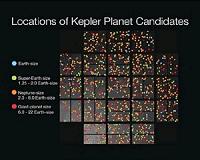 |
Chicago (UPI) Feb 21, 2011 Liquid water may be found on planets that have gone adrift from their stars and may have acted as stepping stones to spread cosmic life, U.S. researchers say. Gravitational battles with other planets or passing stars can fling worlds out of their solar systems, but two scientists from the University of Chicago say these wandering worlds could continue to stay warm thanks to the decay of radioactive elements in their cores, NewScientist.com reported Monday. Dorian Abbot and Eric Switzer say they've calculated that rocky planets with a mass similar to that of Earth could stay warm enough to keep water liquid under thick, insulating ice sheets for more than a billion years. A planet with the same percentage of water as Earth could keep a subsurface ocean liquid if it was 3.5 times Earth's mass, they say, but a planet with 10 times Earth's water concentration could do this even if it weighed just one-third as much as Earth. "It's a really interesting idea," Lisa Kaltenegger of the Harvard-Smithsonian Center for Astrophysics says of their theory. "But we would have to land on [a planet] and burrow down to see if life is possible."
Share This Article With Planet Earth
Related Links Lands Beyond Beyond - extra solar planets - news and science Life Beyond Earth
 Kepler Triples ExoPlanet Count As Search For Biosphere 2 Intensifies
Kepler Triples ExoPlanet Count As Search For Biosphere 2 IntensifiesEureka, CA (SPX) Feb 21, 2011 The rush of data released earlier this month from the Kepler science team is intriguing for what it saw and didn't see in its first 4 months of observations. The relatively small Kepler space telescope is very good at what it does. It has a highly sensitive array of CCDs (light sensors) that has taken about 21 months of data. We saw the release of a small part of that data recently. It rev ... read more |
|
| The content herein, unless otherwise known to be public domain, are Copyright 1995-2010 - SpaceDaily. AFP and UPI Wire Stories are copyright Agence France-Presse and United Press International. ESA Portal Reports are copyright European Space Agency. All NASA sourced material is public domain. Additional copyrights may apply in whole or part to other bona fide parties. Advertising does not imply endorsement,agreement or approval of any opinions, statements or information provided by SpaceDaily on any Web page published or hosted by SpaceDaily. Privacy Statement |